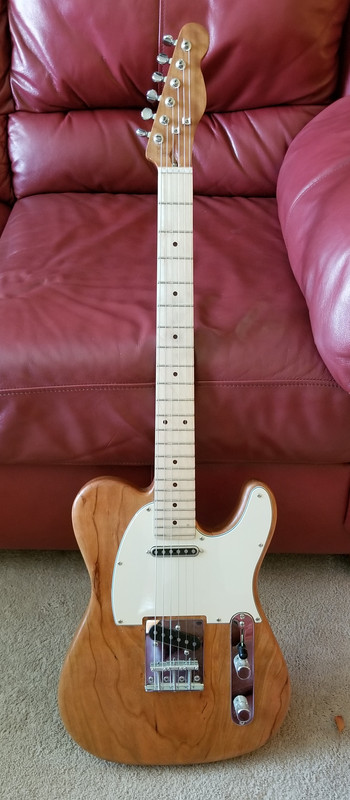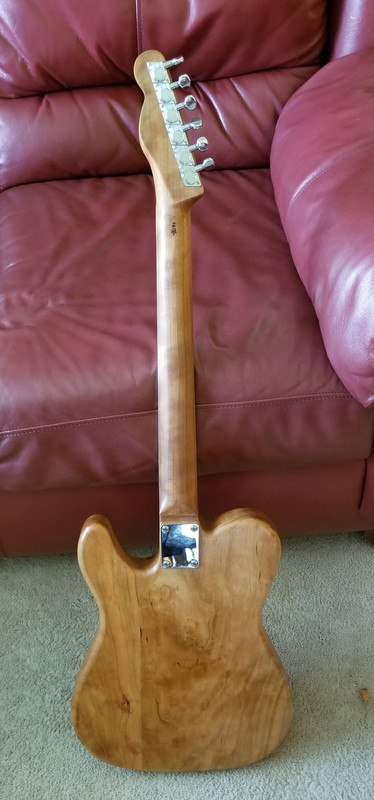This is the first guitar I've made, sort of on the quick just to learn where the trouble spots will be on subsequent guitars. I've got some cosmetic issues from trying to do things with hand tools that should've been done (either differently with hand tools or just with power tools) The only marked issues are the dot on the back of the neck and the attempt in anger to get an angle with a gouge toward the truss rod nut will result in the need to make a custom truss rod cover.
The bridge is a chinese toploader copy, but the rest of the electronics are respectable US made components, or high quality korean (the tuners). I have done some work on guitars before (fret leveling, etc) so there aren't any playability issues, it plays really well. It's helpful to correct a few well used guitars before making a new one, so you know what to avoid (sharp frets, high frets, nut issues, etc).
Spending the money on high quality pre-wired components and american made pickups makes it sound better than the am. standard fender telecaster that I used to have.
The cherry with varnish makes it look unique, though it'd look better if the body was one piece. So, I ordered a large 10/4 table slab to cut future bodies from, and the edges of the slab are rift, so they'll make good neck stock and I can get proper orientation by having a large slab to cut from.
The varnish is epifanes. I think it looks fine, it doesn't have enough build to show a strange hue, and the cherry under it will force an amber color. I made a batch of turpentine/damar/pine resin varnish last weekend that I'll use from this point on, but it probably wasn't necessary (certainly smells a lot better than epifanes). I'm well aware that acrylic and nitro are the standards these days, and I have both on hand, but I think I want to go with violin varnish. If time and budget allow, I'm going to make five of these, and then move on to more difficult guitars, hopefully culminating with a hand made arch top in the style of benedetto.


Total cost with good electronics and all of the materials was about $300.
Mod Edit:- image links modified.
The bridge is a chinese toploader copy, but the rest of the electronics are respectable US made components, or high quality korean (the tuners). I have done some work on guitars before (fret leveling, etc) so there aren't any playability issues, it plays really well. It's helpful to correct a few well used guitars before making a new one, so you know what to avoid (sharp frets, high frets, nut issues, etc).
Spending the money on high quality pre-wired components and american made pickups makes it sound better than the am. standard fender telecaster that I used to have.
The cherry with varnish makes it look unique, though it'd look better if the body was one piece. So, I ordered a large 10/4 table slab to cut future bodies from, and the edges of the slab are rift, so they'll make good neck stock and I can get proper orientation by having a large slab to cut from.
The varnish is epifanes. I think it looks fine, it doesn't have enough build to show a strange hue, and the cherry under it will force an amber color. I made a batch of turpentine/damar/pine resin varnish last weekend that I'll use from this point on, but it probably wasn't necessary (certainly smells a lot better than epifanes). I'm well aware that acrylic and nitro are the standards these days, and I have both on hand, but I think I want to go with violin varnish. If time and budget allow, I'm going to make five of these, and then move on to more difficult guitars, hopefully culminating with a hand made arch top in the style of benedetto.


Total cost with good electronics and all of the materials was about $300.
Mod Edit:- image links modified.




































